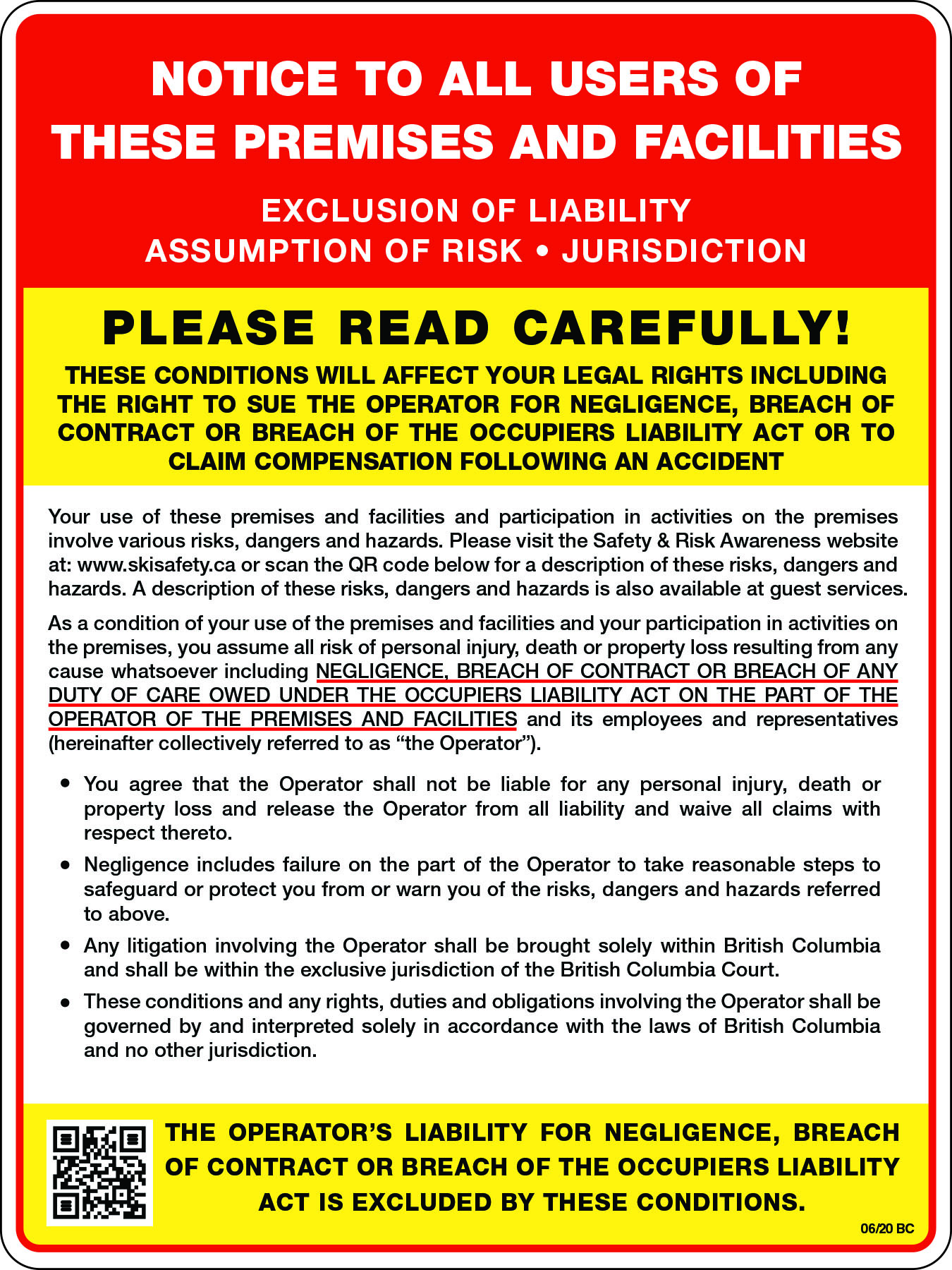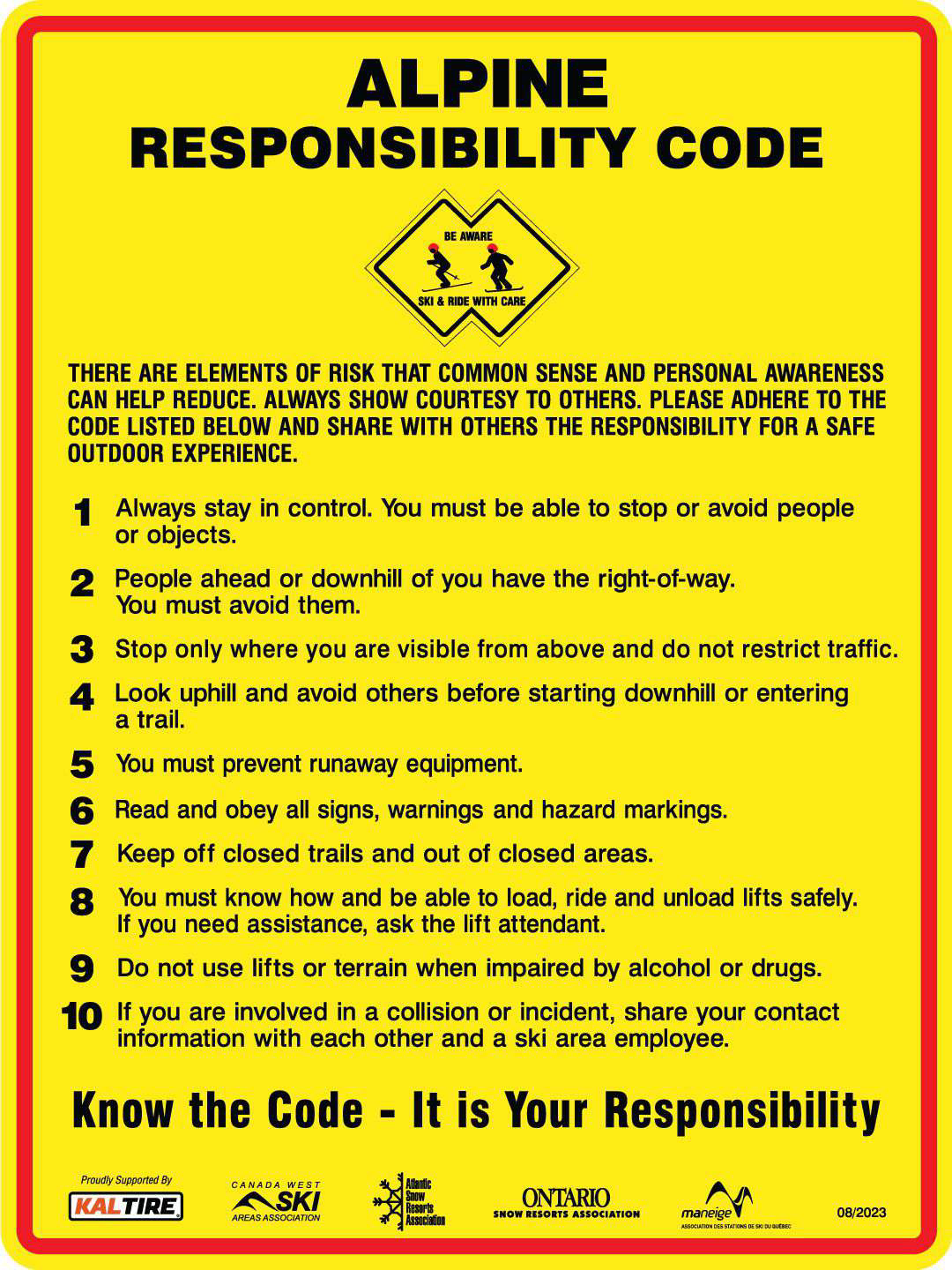EXCLUSION OF LIABILITY – ASSUMPTION OF RISKS
Skiing, snowboarding, and cross country skiing (nordic) involve various risks, dangers and hazards including, but not limited to the following:
- Boarding, riding, and disembarking ski lifts
- Changing weather conditions
- Avalanches
- Exposed rock, earth, ice, and other natural objects
- Trees, tree wells, tree stumps, and forest deadfall
- The condition of snow or ice on or beneath the surface
- Variations in the terrain which may create blind spots or areas of reduced visibility
- Variations in the surface or sub-surface, including changes due to man-made or artificial snow
- Variable and difficult conditions
- Streams, creeks, and exposed holes in the snowpack above streams or creeks, cliffs, or crevasses
- Snowcat roads, road banks, or cut-banks
- Collision with lift towers, fences, snowmaking equipment, snow grooming equipment, snowcats, snowmobiles, or other vehicles, equipment, or structures
- Encounters with domestic and wild animals including dogs and bears
- Collision with other persons
- Loss of balance or control, slips, trips, and falls
- Accidents during snow school lessons
- Negligent first aid
- Failure to act safely or within one’s ability or to stay within designated areas
- Negligence of other persons and negligence on the part of the operator and its directors, officers, employees, instructors, agents, representatives, volunteers, independent contractors, subcontractors, sponsors, successors and assigns
alpine responsibility code
The Alpine Responsibility Code provides the basic rules of conduct and must be followed by all using the terrain, and is consistent across all Ski Areas of Western Canada.
- Always stay in control. You must be able to stop or avoid other people or objects
- People ahead of you have the right-of-way. You must avoid them
- Stop only where you are visible from above and do not restrict traffic
- Look uphill and avoid others before starting downhill or entering a trail
- You must prevent runaway equipment
- Read and obey all signs, warnings and hazard markings
- Keep off closed trails and out of closed areas
- You must know how and be able to load, ride and unload lifts safely. If you need assistance, ask the lift attendant.Do not use lifts or terrain when impaired by alcohol or drugs
- If you are involved in a collision or incident, share your contact information with each other and a ski area employee.
KNOW BEFORE YOU GO
In addition to the Alpine Responsibility Code, here are some additional tips to keep you safe and enjoy your day on the slopes:
Weather
- Plan ahead for variations in weather. Dress appropriately, and have properly tuned gear. Warmth and visibility are key safety components
- UV rays are reflected from the snow surface. Always wear sunscreen and goggles or sunglasses, even on cloudy days
- Cold temperatures increase the likelihood of frostbite. Dress warm, bring extra layers and keep an eye on exposed skin. Go inside immediately if the skin begins to turn white
- Take note of the conditions. When the snow surface is hard and fast, it is easy to ski/ride at high speed, increasing the risk of serious injury if you fall and slide. Be aware of changing snow surface conditions
Food & water
- Keep hydrated and carry water with you
- Carry a portable snack with you to keep you fueled
Buddy up
- Ski with a buddy or group of other people
- Identify meeting points with your group in case you become separated. All group members should know where to meet should separation occur
- Carry a whistle and be particularly cautious when skiing/riding in the trees. Tree wells are a real risk. See more on TREE WELL SAFETY
Helmets
- It is highly recommended to wear a helmet while skiing and riding. Skiers and snowboarders are encouraged to educate themselves on the benefits and limitations of helmet usage
See more on snow sports helmets
Know your limits
- Don't overdo it and be aware of fatigue. Many visitors are not conditioned to ski/board long days
- Warm-up in the morning and stretch it out, then tone it down in the afternoon
Vehicles
- Snowcats and snowmobiles may be encountered during operating hours. Give these vehicles plenty of space
Surroundings
- Be aware of your surroundings and be mindful of where you stop on the hill, for your safety and the safety of other skiers and snowboarders
- When resting, move over to the side of the run
- Never stop under a roller, jump, cat track, or on a blind corner, as uphill skiers will not be able to see you
- Always be aware of other skiers and snowboarders. Look uphill before you commence downhill, and yield to other skiers and snowboarders


